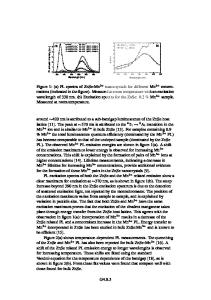Preparation, structural characterization, and luminescence properties of Eu 3+ -doped nanocrystalline ZrO 2
- PDF / 1,220,971 Bytes
- 12 Pages / 612 x 792 pts (letter) Page_size
- 112 Downloads / 293 Views
. Riello, S. Bucella, and A. Benedetti Università Ca’ Foscari di Venezia, Dipartimento di Chimica Fisica and INSTM, Via Torino 155/ b, I-30170 Venezia-Mestre, Italy (Received 18 January 2005; accepted 7 July 20005)
Eu3+-doped zirconia nanopowders were prepared by the sol-gel technique using two different methods, based on the hydrolysis of zirconium n-propoxide, producing tetragonal and monoclinic zirconia under different preparation conditions. A detailed microstructure characterization was performed through wide angle x-ray scattering, small angle x-ray scattering, trasmission electron microscopy, and nitrogen physisorption measurements. The possible influence of the zirconia crystalline phases and particle sizes on the luminescence properties of the lanthanide ion was investigated. A detailed analysis of the emission spectra of the samples suggested that the dopant Eu3+ ions replace the Zr4+ ions in the zirconia crystal lattice. Moreover, samples prepared by the two different methods were characterized by different decay times of the Eu3+ ion luminescence.
I. INTRODUCTION
For many years a lot of effort have been made in the search for the development of efficient phosphors for lamps or displays based on the emission of rare-earth (RE) ions.1 Many of them were incorporated using different routes into a large variety of inorganic oxide hosts such as alumina, yttria, titania, silica, ormosil (organically modified silicate), and ormocer (organically modified ceramic).2–7 Lanthanide-doped zirconium oxide and oxynitrides have been shown to be very interesting as luminescent materials,5,8–11 also due to their better chemical and photochemical stabilities, higher refractive index, and lower phonon energy than other oxide hosts, such as TiO2 and SiO2. On the other hand, the study of the luminescent properties of lanthanide doped nanocrystalline oxide particles12,13 has been of paramount importance, in particular focusing the attention on both the theoretical aspects involving the mechanisms of the luminescent processes, and on the possible applications, especially in the field of phosphors for displays. Many investigations were carried out especially on lanthanidedoped nanocrystalline sesquioxides, as for instance Y2O3 and Lu2O3.14,15 a)
Address all correspondence to this author. e-mail: [email protected] DOI: 10.1557/JMR.2005.0358 2780
http://journals.cambridge.org
J. Mater. Res., Vol. 20, No. 10, Oct 2005 Downloaded: 30 May 2014
Many different methods have been used in the past to prepare Eu3+-doped ZrO2 monoliths, powders and thin films, including coprecipitation,16 sonochemical,17 pyrosol,18 and sol-gel techniques.19,20 The luminescence properties of Eu3+-doped monoclinic and tetragonal zirconia powders have been investigated by many authors, such as van der Voort,8 Dexpert-Ghys,21 and Gutzof,22 underlining the importance of this material as a phosphor. Moreover, it is well known that the Eu3+ ion is useful as a probe in identifying the local structure around the lanthanide ion, especially for disordered
Data Loading...











